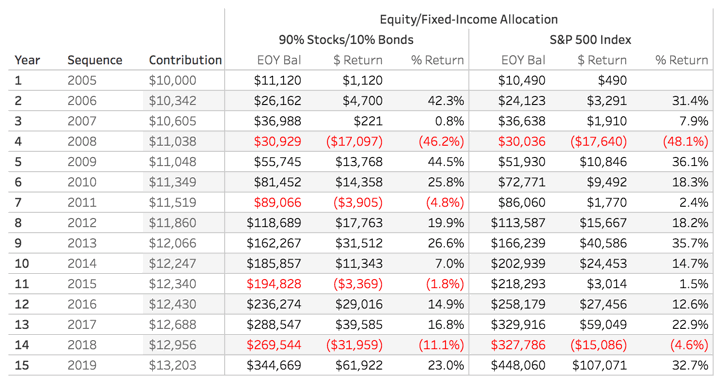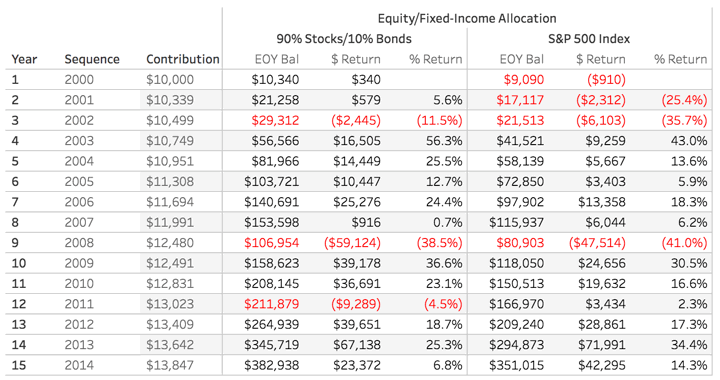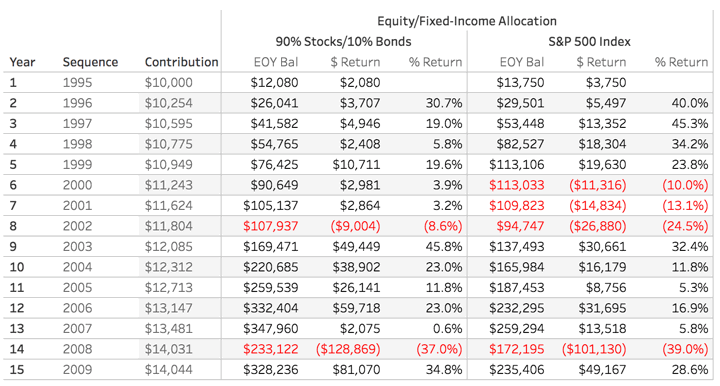Most people must rely on the power of smaller, regular investments from work income to build up their retirement nest egg. In the latest Sound Investing email, Paul Merriman shared a new Lifetime Investment Calculator that helps you see how these gradual investments (dollar-cost averaging) would have added up during various periods, using actual historical returns from 1970 to 2020.
I’ve already tried to illustrate how regular investments of $250 or $500 a month can add up over time. But instead of having to manually gather performance numbers from a Vanguard Target Retirement fund in a spreadsheet, this fancier calculator lets you adjust many more variables. You can choose different asset allocations, stock/bond ratio, investment amounts, and so on. Importantly, the calculator uses actual historical returns, so you can see what would happen if you invested through the 2001 dot-com bust, 2008 financial crisis, and so on.
You can start the sequence of returns from any of the 51 years to replicate your financial picture as if your decisions were available in the past. For example, you could simulate the role of luck by starting or ending your journey in a bull or bear market. It is not a financial planning calculator per se, nor meant to be a complete planning tool, but it allows you to customize both growth (accumulation) and distribution phases based on your personal timeline and investments.
If you aren’t familiar with Paul Merriman, he is an advocate of adding a bit of complexity to index fund portfolios via additional exposure to smaller and value-oriented companies. For a test run, I went for the “Ultimate Buy and Hold Worldwide (70% US/30% International)” portfolio, alongside a simple S&P 500 portfolio.
Here is $10,000 invested every year for 15 years, with small ~3% increases each year with inflation (ideally corresponding with a higher paycheck), starting in 2005:

Here is $10,000 invested every year for 15 years, with small ~3% increases each year with inflation (ideally corresponding with a higher paycheck), starting in 2000:

Here is $10,000 invested every year for 15 years, with small ~3% increases each year with inflation (ideally corresponding with a higher paycheck), starting in 1995:

You can see that an internationally-diversified portfolio may not be the best in some periods, but it also may not be the worst in others. (I admit I am a bit confused as to why the performance numbers for any given year are slightly different for each test run, perhaps someone out there can explain that to me.)
Even in the 1995-2010 period that contained both the 2001 dot-com bust and the 2008 financial crisis, your ending balance would still have ended up much higher than your total contributions with the internationally-diversified portfolio.

 The Best Credit Card Bonus Offers – 2025
The Best Credit Card Bonus Offers – 2025 Big List of Free Stocks from Brokerage Apps
Big List of Free Stocks from Brokerage Apps Best Interest Rates on Cash - 2025
Best Interest Rates on Cash - 2025 Free Credit Scores x 3 + Free Credit Monitoring
Free Credit Scores x 3 + Free Credit Monitoring Best No Fee 0% APR Balance Transfer Offers
Best No Fee 0% APR Balance Transfer Offers Little-Known Cellular Data Plans That Can Save Big Money
Little-Known Cellular Data Plans That Can Save Big Money How To Haggle Your Cable or Direct TV Bill
How To Haggle Your Cable or Direct TV Bill Big List of Free Consumer Data Reports (Credit, Rent, Work)
Big List of Free Consumer Data Reports (Credit, Rent, Work)
Have you read these findings about lump sum investing? https://www.northwesternmutual.com/life-and-money/is-dollar-cost-averaging-better-than-lump-sum-investing/
Their analysis appears to include 10 years vs. 15 years or longer, but still interesting an case to make, seems a little against the grain. Going with a lump sum, even if it works out there could be sleepless nights, and requires patience whereas dollar cost averaging takes discipline and dedication, still I think most would feel like a sense of control on how and when to invest periodically. The emotional aspect of investing is critical which needs to be factored in with either option.
I agree that lump-sum investing vs. DCA is a long-standing debate and there is no fixed answer for each person, but for most people saving their paycheck, lump-sum and dollar-cost averaging are the same. 🙂 You are simply investing your money as soon as you get it.
Playing with the calculator, it looks like the rates of return change if yu change the annual deposit amounts. Since the depots increase over time they will differ for given year depending on the starting year.
Should rates of return change given the deposit size though? Even if your portfolio is 100% S&P 500? *Shrug*
Oh, I got it. When they calculate the return, they’re not considering the contributions of the year. When you add those in, the actual return for the S&P fund is -37% in 2008 in all three scenarios.
It’s not fair to count the contributions throughout the year either at the beginning, end, or not at all, though, if they were dollar-cost averaged throughout the year. You need a more advanced formula to account for how long each contribution was invested.
Consider a year where the market dropped by 50% (on a steady decline). $100k at the beginning would be $50k at the end. However, the $10k you invested throughout the year would be worth more than $5k (maybe $7k), since you were buying in every month at lower and lower prices throughout the year. So your $100k + $10k would be worth $57k at the end, not $55k. That might be called a 48.1% loss ($53k loss on $110k total investment).
Now imagine you had $500k at the beginning, invested a similar $10k throughout the year, and ended up with $257k. That would be a 49.6% loss. A bigger loss in the same market.
In a down year, the more money you put in during the year (after the market has started to drop), the better your overall return will be. If this is earlier in your career, your contributions will be a bigger percentage of your total bucket and offset your previous balance. Later in your career, it makes a much smaller dent.
Thanks for shedding some light on this.
So is the take away here to accelerate investing in down markets? The worse the market looks, up the ante? I think that makes sense, as long as the investor is methodical. Meaning, if you divvy up 4 quarters (knowing it’s going to be turbulent year, like 2022), invest 10k, 15k, 20k, 25k (assuming you had that much) at the end of each quarter, you’ll probably come out ahead more quickly in 1-3 years or however long recessions typically last. Actually, one might want to invest more frequently at the tail end, instead of at the end of the quarter, why not end of Oct. Nov. and Dec. to cover all the bases so to speak?